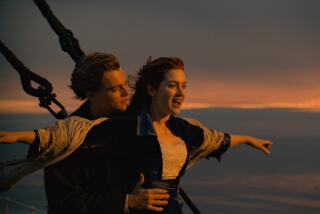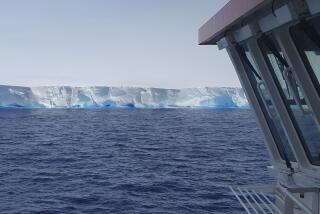Leap in Technology : ‘Pac-Man’ Sees ‘Breathtaking’ Titanic Images
- Share via
WOODS HOLE, MASS. — The tiny electronic “swimming eyeball” used to photograph ornate crystal chandeliers and marble columns deep inside the sunken Titanic represents a major advance for marine science and exploration, scientists and Navy officials said here Wednesday.
It is “a quantum leap in deep-dive technology,” said U.S. Navy Cmdr. Mark Neuhart, a spokesman for the deep-sea exploration of the long-lost wreck of the famed luxury liner.
“With this capability, we’ll be able to both explore and perform experiments at depths and locations unheard of before,” said Dr. John Steele, director of the Woods Hole Oceanographic Institution, a nonprofit scientific institute coordinating the historic expedition.
Deceptively Easy to Run
While the technology of the lawnmower-sized, remote-controlled, propeller-driven probe called Jason Jr. is complex, running it appears deceptively simple.
An operator in a nearby three-man mini-submarine uses a joy stick from a console on his lap and watches a video monitor, much like a video arcade game, to guide the royal blue probe through the giant ship’s pitch-black interiors.
“It’s a lot harder than Pac-Man,” said Dr. Dana R. Yoerger, a member of the institution team that developed the probe last winter. “Imagine playing Pac-Man where you can only see through Pac-Man’s eyes. You can’t see the maze. You can’t see the goblins. You can only see what’s ahead of you. . . . The problems are formidable.”
Mixed with the excitement over the new technology is the undeniable emotion sweeping this usually sleepy seaside village as expedition leader Dr. Robert Ballard radios back daily details of man’s first return to the ship some 2 1/2 miles underwater.
“You can’t help but feel it,” Ballard said excitedly in a ship-to-shore call.
“You have these flashbacks that Capt. Smith stood here, and (financier John Jacob) Astor was there, and that’s where they loaded the women and children into the boats. You don’t hear them, you just feel them,” Ballard said. “You remember the staircase scene with people going up and down the staircase, and you remember the band playing.”
74 Years Since the Tragedy
It has been 74 years since the grand salon band last played to calm panicking passengers until the world’s largest and most luxurious ship slipped through the icy North Atlantic and settled in darkness 12,500 feet below. With too few lifeboats, more than 1,500 people died and only 703 survived.
Using unmanned camera-carrying submersibles, Ballard’s team found the wreck about 400 miles southeast of Newfoundland last September. Based on the research vessel Atlantis 2, the scientists have descended in the mini-submarine Alvin four times so far this week, to study and photograph the wreck’s decay, to land repeatedly on the decks and bridge and to send the probe, Jason Jr., into first-class rooms and a gymnasium.
“We refer to it as our swimming eyeball,” Cmdr. Neuhart said.
In an eight-hour dive Wednesday, Ballard and two other scientists landed the Alvin by the ship’s wheelhouse and used the Jason Jr. to look into windows of the crew’s quarters, then to investigate the crow’s nest and a brass mast light atop a forward mast.
Observes Crow’s Nest
It was from the crow’s nest that two forward observers first sighted the gleaming iceberg in the still waters just before midnight on April 14, 1912. The 882-foot-long ship, steaming nearly full speed despite repeated radio warnings of ice, sliced a 300-foot-long gash in its double-bottomed starboard hull as it grazed the giant berg.
In a ship-to-shore call to Woods Hole Institution colleagues early Wednesday night, Ballard said that after observing the crow’s nest, the scientists then landed the Alvin on the starboard boat deck. They maneuvered the robot through a doorway where it photographed the cavernous gymnasium, posh officers’ quarters and the grand promenade.
The Jason Jr. then floated down a first-class staircase and again photographed unbroken crystal chandeliers. Hauling the probe out, the Alvin returned to the boom on the bow and found “some sort of writing about the Glasgow works,” where parts of the ship were built, on the still-shiny brass windlasses.
“It was the best day yet,” Ballard said. “The (photographic) imaging was breathtaking.” Ballard said no human remains were sighted.
Scientists at Controls
Institution scientists Martin Bowen piloted the Jason Jr., while Will Sellars operated the mini-submarine.
The Navy’s Office of Naval Research is backing the $20,000-a-day, three-week expedition as part of a $2.8-million, five-year contract with the institution to develop the Argo/Jason system to map, research and explore the ocean bottom.
Tested for the first time on this trip, the prototype Jason Jr. has a titanium hull and is 20 inches high, 27 inches wide and 28 inches long. Compact electric motors power four propellers, enabling it to “swim” in any direction.
The probe is neutrally buoyant, and uses three 400-watt flood lamps and a powerful strobe light to shoot high-resolution color video and still pictures from rotating cameras. It is tethered to the 25-foot-long Alvin by a 200-foot half-inch-thick cable and operated through a small computer system. Sensors measure both heading and pressure.
Highly Accurate Sensor
“It sounds simple, but the pressure sensor can resolve one inch of depth at the bottom of the ocean,” Yoerger said.
He said ambient pressure at the Titanic is about 5,800 pounds per square inch, or nearly 400 times atmospheric pressure at sea level.
By next year, scientists and engineers here will redesign a larger, 1,000-pound Jason probe with a mechanical arm and other devices. It will operate from another unmanned probe called the Argo, enabling it to dive to 20,000 feet. The manned sub Alvin can only dive to about 13,000 feet
“The real leap forward is still ahead, when we put it all together,” said Woods Hole Institution director Steele.
He said the redesigned probe will be able to collect samples from super-heated vents in the earth’s crust deep under the Atlantic and Pacific oceans. Scientists want to map and study how the 300-degree Centigrade temperatures at the vents affect forces on geological plates, ocean chemistry and unknown biological forms.
Offers Great Capability
“The most spectacular mountain ranges, the deepest canyons and the most bizarre terrain on earth is found under water,” Yoerger said.
For the Navy, Neuhart said, the technology offers the capability to “search and identify objects on the ocean floor from large ships and planes, to small objects like spent ordnance and missile boosters.”
Neuhart said the probe’s “ability to both penetrate and photograph restricted areas provides us with a visual imaging capability that we have not had to this point.”
Items of military interest include the U.S. nuclear submarine Thresher, which sank in the Atlantic in 1963, an American hydrogen bomb lost off the coast of Spain in 1966, a Soviet submarine that exploded and sank between Hawaii and Midway in 1968, and the U.S. nuclear submarine Scorpion, which sank off the Azores in 1968.
Missile Application Sought
Deep-sea probes are also essential for anti-submarine warfare and the navigation of submarine-launched missiles. The Navy also wants the probes to help explore the feasibility of basing missiles on the ocean bottom.
Various entrepreneurs and treasure hunters have talked of plans to salvage the 45,000-ton Titanic, or parts of it, or even to take sightseers down in private submarines.
But Ballard said wood on the wreck appeared badly eaten by deep-sea organisms, despite the cold, airless water, and that the steel superstructure is badly rusted. The decay appears so bad, he said, that the ship is “totally unsalvageable. There’s just no way to raise it.”
Only two other submarines, the U.S. Navy’s Sea Cliff and the French government’s Nautile, are known to operate at the Titanic’s depth. Yoerger said privately owned remote-operated vehicles can only dive to 7,500 feet.
Prefers Adventure
“To try to move a large fragile structure like that would be virtually impossible without severely damaging the ship,” he said. “Someone could make a serious attempt. I can’t say they’d succeed or how much it would cost.”
Yoerger said the future of ocean research lies in unmanned probes like Jason Jr. But the adventure lies elsewhere.
“Remote operated vehicles give invaluable data,” he said wistfully. “But landing on the deck of the Titanic, well, that’s something else again.”
More to Read
Sign up for Essential California
The most important California stories and recommendations in your inbox every morning.
You may occasionally receive promotional content from the Los Angeles Times.












